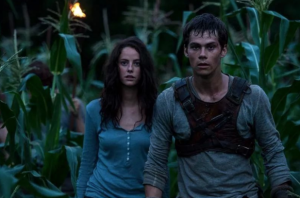Metro Canada: Filmmakers have been using mazes to amaze audiences for years
 Giant labyrinthine puzzles are almost as old as mankind: Prehistoric mazes were built as traps for malevolent spirits, while in medieval times the labyrinth represented a path to God. But recently, the idea of people struggling through a complicated network of paths has made for some striking visuals in movies.
Giant labyrinthine puzzles are almost as old as mankind: Prehistoric mazes were built as traps for malevolent spirits, while in medieval times the labyrinth represented a path to God. But recently, the idea of people struggling through a complicated network of paths has made for some striking visuals in movies.
This weekend, The Maze Runner sets much of its action inside a gigantic maze where frightening mechanical monsters called Grievers wander, tormenting Thomas (Dylan O’Brien) as he navigates the maze to pick up clues that help him piece together memories of his past. The sci-fi story is just the latest to feature a maze as a major plot point, but just as Labyrinth’s Sarah (Jennifer Connelly) is warned, “nothing is as it seems” in these movie puzzles.
Remember Harry Potter and the Goblet of Fire? Like Thomas in The Maze Runner, the boy wizard has to make it through a maze (in this instance to find the Triwizard Cup), but instead of fighting magical creatures, this hedge maze is magical; shape shifting to make the journey extra difficult. The 1972 horror film Tales from the Crypt contained an even more sinister maze.
Made up of five stories, the film culminated with the tale of a labyrinth told with razor-sharp wit. Set in a home for the blind, the patients get even with the institute’s cruel director by placing him in the centre of a maze of narrow corridors lined with razor blades. It’s a cutting edge story, that, according to besthorrormovies.com “rivals the ‘death traps’ of Saw and ‘tortures’ of Hostel while only showing a single small cut of the flesh.”
In The Shining, the axe-wielding father Jack Torrance (Jack Nicholson) chases his son Danny (Danny Lloyd) through the Overlook Hotel’s hedge maze. The quick-thinking boy escapes by retracing his steps, confusing his maniacal dad. The documentary Room 237 offers up a number of interpretations of what the maze and Danny’s escape represents. One theory suggests it reflects Greek hero Theseus’ slaying of the Minotaur and escape from the labyrinth, while another speculates it’s a metaphor for conquering repression. Whatever the subtext, it remains one of director Stanley Kubrick’s most tense scenes.
And finally, Francis Ford Coppola’s version of Dracula sees Lucy (Sadie Frost) sleepwalking through a garden maze, chased by Dracula (Gary Oldman) in wolfman form while Pan’s Labyrinth features a maze as a place of safety for Ofelia (Ivana Baquero) to evade her attacker.
